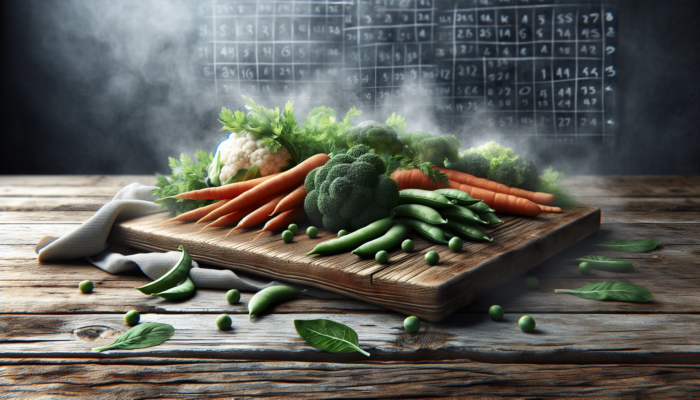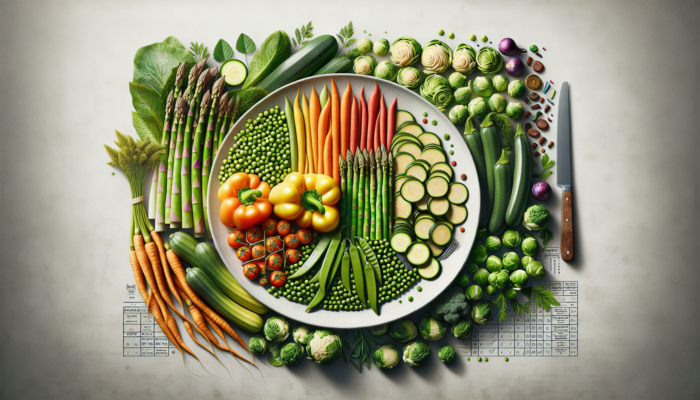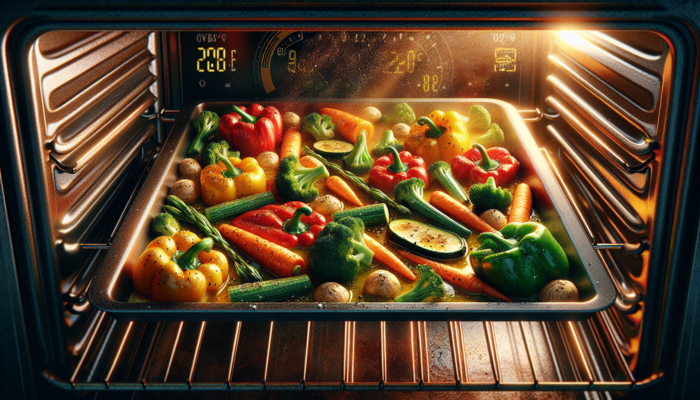Unlock the Secrets to Cooking Vegetables for Ultimate Crispiness and Flavor
Achieving the perfect doneness in vegetables while steering clear of a mushy texture is an essential skill in the culinary arts. This skill combines precise techniques, ideal cooking times, and the right kitchen tools to create delicious results. Understanding the unique characteristics of each vegetable is vital, as it allows you to select the most effective cooking methods and adjust conditions accordingly to achieve a satisfying crunch. This detailed guide immerses you in the diverse world of vegetables, equipping you with invaluable insights and techniques to prepare them while retaining their crisp texture and amplifying their flavors.
How to Select Vegetables That Keep Their Crispness While Cooking

The journey to achieving a delightful crunch in your dishes starts with the careful selection of vegetables. Different varieties exhibit varying levels of resilience; understanding which vegetables maintain their texture under specific cooking methods can greatly impact the success of your culinary creations. By familiarizing yourself with these resilient types, you can make savvy choices that enhance your cooking journey and lead to superior results.
Discover the Best Vegetables That Effectively Maintain Their Crispness
Several vegetables are naturally predisposed to retain their crunchiness more effectively than others. For instance, carrots, broccoli, and snap peas are renowned for their sturdy texture when cooked correctly. These vegetables contain high water content along with strong structural integrity, enabling them to withstand heat without becoming mushy. In contrast, softer options such as zucchini and eggplant can easily lose their firmness if not cooked with care. Understanding which vegetables are resilient will enhance your culinary skills and positively affect your cooking choices.
Essential Tips for Selecting Fresh Vegetables for Outstanding Cooking Results
Freshness is crucial for maintaining the ideal texture of vegetables during cooking. When selecting vegetables, look for vibrant colors, a firm touch, and the absence of blemishes or soft spots. For example, green beans should emit a satisfying snap when bent, while brussels sprouts should feel dense and compact. For the freshest produce, consider visiting local farmers' markets or organic grocery stores, as they often offer superior options compared to conventional supermarkets, significantly improving your chances of achieving that perfect crunch.
Seasonal Vegetable Choices That Keep Their Texture During Cooking

The seasonal availability of vegetables greatly influences their quality and flavor profile. In spring, opt for asparagus and peas, both of which retain their texture beautifully when prepared correctly. Summer brings a wealth of options like bell peppers and corn, while autumn is the season for hearty choices such as cauliflower and carrots. Cooking with seasonal produce not only enhances the flavor profile of your meals but also ensures that you are using vegetables at their peak freshness and nutritional value.
Effective Cooking Methods to Prevent Vegetables from Becoming Mushy
The cooking method you select has a profound impact on the final texture of your vegetables. Certain techniques excel at preserving their original texture, ensuring they remain crisp and enjoyable to eat.
Steaming: A Gentle Technique for Cooking Vegetables
Steaming is a highly effective method that allows vegetables to maintain their crunch without sacrificing their flavor. This gentle cooking approach uses steam to tenderize the vegetables, helping them retain both their vibrant color and texture. The key to successful steaming lies in precise timing—oversteaming can lead to mushiness. Aim for a steaming duration of about 4-7 minutes for most vegetables, checking for doneness regularly. Using a steaming basket ensures even cooking, resulting in a delightful and nutrient-rich dish that highlights the vegetables' natural characteristics.
Roasting: Enhance Flavor While Preserving Vegetable Texture

Roasting is another fantastic technique for achieving vegetables that are free from mushiness. The high, dry heat of the oven caramelizes the natural sugars in vegetables, intensifying their flavors while keeping them firm and crisp. Ensure your oven is preheated to a high temperature of approximately 220°C (425°F), and cut your vegetables into uniform sizes to guarantee even cooking. Toss the vegetables in a small amount of olive oil, season with salt and pepper, and roast until tender yet still crisp, typically taking around 20-30 minutes for the best results.
Quick Sautéing Techniques for Perfectly Crisp Vegetables
Sautéing is a fast cooking method that can yield perfectly crisp vegetables when done correctly. The secret lies in using a hot pan and a minimal amount of oil to quickly sear the vegetables. Start by heating your pan until it’s hot, then add the oil, followed by your chopped vegetables. Stir frequently and cook for only a few minutes to ensure they retain their vibrant color and crunch. This method works exceptionally well for bell peppers, broccoli, and asparagus.
Blanching and Shocking: Techniques to Preserve Vegetable Crunch
Blanching is an excellent technique for maintaining both color and texture in vegetables. This method involves quickly boiling the vegetables before plunging them into ice water, halting the cooking process and locking in crunchiness. Blanching is particularly beneficial for vegetables like green beans and broccoli, which can then be sautéed or added to salads, providing an added crunch that enhances the overall dish.
Master Timing and Temperature for Crispy Vegetables
Understanding the importance of timing and temperature is key in your efforts to avoid mushiness in cooked vegetables. Each vegetable has an optimal cooking time and temperature range that greatly influences the final outcome, ensuring a delicious and visually appealing dish.
Recommended Cooking Times for Various Vegetable Types
Cooking times can vary widely among different vegetables. For instance, carrots may require about 6-8 minutes to steam, while spinach only needs around 2-3 minutes. Keeping a handy reference guide of cooking times for your favorite vegetables can streamline meal preparation, ensuring that all components come together seamlessly without the risk of overcooking any elements.
Control Cooking Temperatures for Optimal Vegetable Preparation
Maintaining control over cooking temperatures is essential for achieving perfectly cooked vegetables. Cooking at excessively high temperatures can char the exterior while leaving the interior undercooked, resulting in uneven textures. Conversely, cooking at too low a temperature may lead to limp vegetables. For most stovetop methods, medium-high heat is ideal, while oven roasting typically requires a higher temperature to achieve caramelization without compromising texture.
Assess Vegetable Doneness Without Overcooking
Checking for doneness without overcooking is a vital culinary skill. For most vegetables, a fork or knife should easily pierce through with minimal resistance, indicating they are cooked yet still firm. If you're uncertain, tasting is a reliable method—remove a piece from heat and take a quick bite. Remember that vegetables will continue to cook even after being removed from heat, so it's wise to err on the side of caution to maintain their ideal texture.
Adjust Cooking Times for Altitude and Humidity Conditions
Altitude and humidity can significantly affect cooking times. At higher altitudes, water boils at lower temperatures, meaning vegetables may require longer cooking times to become tender. In contrast, in humid environments, they may retain more moisture, necessitating adjustments in cooking durations. Being cognizant of these factors and adapting your methods accordingly is essential for achieving consistent culinary results.
Essential Kitchen Tools for Preserving Vegetable Texture
Equipping yourself with the right kitchen tools can dramatically enhance your ability to achieve optimal texture when cooking vegetables. Various gadgets can improve your cooking experience and the outcomes of your culinary endeavors.
Utilizing Steamers and Racks to Prevent Direct Contact with Heat
Steamers are invaluable tools for cooking vegetables without turning them mushy. They promote even cooking while preventing vegetables from sitting in water, which can lead to sogginess. Consider investing in a tiered steamer or a bamboo steamer, which can accommodate various types of vegetables simultaneously, saving time and effort in your cooking routine while ensuring consistent results.
The Advantages of Air Fryers for Achieving Crispy Vegetables
Air fryers have surged in popularity due to their ability to create crispy textures without excessive oil. These appliances circulate hot air around the food, resulting in a crispy exterior while keeping the interior tender. This cooking method is particularly well-suited for vegetables such as zucchini fries and sweet potato wedges, allowing you to enjoy your favorite dishes without sacrificing health or texture.
Selecting the Right Cookware for Cooking Vegetables
Choosing the appropriate cookware can significantly affect how your vegetables cook. Lightweight pans, such as skillets or sauté pans, heat up quickly and provide even cooking, crucial for achieving that perfect crispy texture. Non-stick options can also be advantageous, as they require less oil and facilitate easier flipping and stirring of your vegetables during cooking.
Innovative Kitchen Gadgets for Achieving Ideal Vegetable Texture
Beyond the essentials, several innovative kitchen gadgets can assist you in achieving impeccable vegetable texture. Investing in a mandoline slicer for uniform cuts or a vegetable peeler to create ribbons of zucchini or carrots can streamline preparation and ensure even cooking, crucial for preventing mushiness and enhancing the overall appeal of your dishes.
Flavoring Techniques That Keep Vegetable Texture Intact
After cooking your vegetables to perfection, the next crucial step is to season them effectively without compromising their texture. Achieving this balance requires a thoughtful approach to flavors and seasoning techniques.
Enhancing Natural Vegetable Flavors Without Overpowering Them
The art of seasoning vegetables effectively focuses on amplifying their natural flavors without overshadowing them. Start with a light sprinkle of salt and pepper, allowing the inherent taste of the vegetables to shine through. Gradually introduce additional seasonings while tasting as you go, to strike the perfect balance that enhances the dish without overwhelming their texture.
Incorporating Herbs and Spices While Maintaining Crispness
Herbs and spices can elevate your vegetable dishes, but their application should be strategic. Fresh herbs like basil or parsley should be added near the end of cooking to prevent wilting, while dried spices can be introduced earlier. This method allows the flavors to infuse without compromising the crispness of your vegetables, resulting in a well-rounded and harmonious dish.
Choosing Marinades and Dressings That Enhance Vegetable Texture
Marinating vegetables can add depth and flavor, but it's essential to employ the right method. Opt for lighter marinades that won't weigh down the vegetables, such as a simple mixture of olive oil, lemon juice, and herbs. Allow them to marinate briefly before cooking to prevent excessive moisture absorption, which can lead to a mushy texture that detracts from the overall appeal of the dish.
Balancing Flavors While Preserving Vegetable Crunch
Finding the right balance between flavors and maintaining texture requires careful consideration of your ingredients. Acidic components, like vinegar or citrus juice, can brighten your dish without compromising texture. Pair these elements with robust vegetables that can withstand bold flavors, ensuring that each bite remains crunchy and satisfying.
Best Storage Techniques for Vegetables to Ensure Cooking Success
Proper storage is vital for maintaining the quality of your vegetables, which directly affects their texture during cooking. The way you store vegetables can significantly influence their cooking performance and flavor retention.
Best Practices for Keeping Fresh Vegetables
To keep your vegetables fresh and crisp, store them in a cool, dry environment, ideally in the refrigerator. Use perforated plastic bags or containers to encourage airflow, reducing moisture buildup that can lead to wilting. For leafy greens, consider wrapping them in a damp paper towel before placing them in a bag to help maintain their crispness and prolong freshness.
Storing Cooked Vegetables for Optimal Texture Retention
When it comes to storing cooked vegetables, careful attention is vital to prevent them from becoming mushy. Allow them to cool completely before transferring them to an airtight container. If possible, store them without added moisture or sauces, as these can lead to sogginess. Reheating in a hot pan can help restore some of the texture lost during storage, ensuring your vegetables remain enjoyable.
Freezing Vegetables for Future Use While Retaining Quality
Freezing vegetables is an excellent method for preserving their quality and texture for later use. Briefly blanching them before freezing helps maintain their color and crunch. Use airtight freezer bags or containers, ensuring you remove as much air as possible to prevent freezer burn. When you're ready to use them, cook them directly from the freezer, adjusting cooking times as necessary for the best results.
The Impact of Storage on Vegetable Cooking Performance
The way you store vegetables can significantly influence their cooking performance. Poor storage conditions can lead to moisture and nutrient loss, resulting in diminished flavors and compromised texture. By understanding the best practices for vegetable storage, you can ensure they remain in optimal condition, ready to be transformed into delightful meals that impress.
Tackling Common Challenges in Vegetable Cooking
Even experienced chefs face challenges when preparing vegetables. Knowing how to troubleshoot these common problems can prevent your dish from becoming a culinary disappointment.
Reviving Overcooked Vegetables to Restore Their Texture
Overcooked vegetables often result from cooking at excessively high temperatures or for extended periods. To remedy this, consider sautéing them briefly in a hot pan with a small amount of oil, which can help restore some texture. Alternatively, you can incorporate overcooked vegetables into soups or purees, salvaging the dish and minimizing waste.
Managing Vegetables That Have Become Soft
Soft vegetables can be frustrating, especially when you aim for a crunchy texture. If you find your vegetables have turned soft, consider roasting them with a sprinkle of breadcrumbs or cheese to enhance their texture. Alternatively, blending them into a sauce or dip can effectively mask their texture deficiencies, allowing you to enjoy them without waste.
Reviving Vegetables That Have Lost Their Crunch
If you have vegetables that have lost their crunch, soaking them in ice water for several minutes can help restore their texture. After soaking, pat them dry and give them a quick sauté or roast to regain some firmness. This technique is particularly effective for celery and carrots, making them enjoyable once again.
Avoiding Common Mistakes in Vegetable Cooking
Steering clear of common pitfalls is crucial for achieving the ideal texture. One major mistake is overcrowding the pan, which can lead to steaming instead of sautéing. Additionally, neglecting proper seasoning can result in bland flavors. Always taste as you cook and make necessary adjustments to ensure the best outcomes for your dishes.
Frequently Asked Questions About Cooking Vegetables
Which vegetables are ideal for maintaining their texture during cooking?
Vegetables such as carrots, broccoli, and snap peas are outstanding choices for preserving their texture. They possess the structural integrity necessary to remain crisp throughout the cooking process.
What strategies can I implement to prevent my vegetables from becoming mushy?
To avoid mushiness, opt for quick cooking methods like steaming or sautéing, and be cautious to avoid overcooking. Regularly check for doneness to maintain their quality.
Is steaming or roasting more effective for achieving crispness?
Both methods can yield crisp results; however, roasting enhances flavor through caramelization, while steaming is gentler, preserving the vegetables' natural texture and color.
What are the recommended cooking times for various vegetables?
Cooking times can vary significantly; for instance, green beans take about 4-5 minutes to steam, while carrots may require 6-8 minutes. Always verify doneness before serving.
How can I check if my vegetables are fully cooked?
You can test for doneness by piercing them with a fork. They should be tender yet firm. Tasting a piece is also an effective method to assess readiness.
Can I store cooked vegetables without losing their texture?
Yes, you can store cooked vegetables in airtight containers. Allow them to cool completely before sealing, and avoid adding moisture to maintain their texture.
What is the best method for reviving overcooked vegetables?
To revive overcooked vegetables, briefly sauté them in a hot pan with oil or incorporate them into soups or sauces for a flavorful solution that minimizes waste.
How can I balance flavors without compromising crunch?
Utilize light seasonings and introduce fresh herbs towards the end of the cooking process. This enhances flavor without diminishing the vegetables’ crunch.
What common mistakes should I avoid when cooking vegetables?
Avoid overcrowding the pan, overcooking, and neglecting proper seasoning. These errors can result in bland flavors and undesirable textures in your dishes.
Are there specific storage techniques for keeping fresh vegetables?
Store fresh vegetables in a cool, dry environment, ideally in the refrigerator, utilizing perforated bags to allow airflow and prevent moisture accumulation.
Connect with us on Facebook for the latest updates!
The post Cooking Vegetables Without Mushiness: Top Techniques Revealed appeared first on https://cookinggods.com
The Article Top Techniques for Cooking Vegetables Without Mushiness Was Found On https://limitsofstrategy.com
The Article Cooking Vegetables Without Mushiness: Essential Techniques First Appeared ON
: https://ad4sc.com

